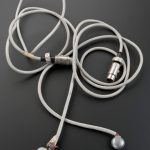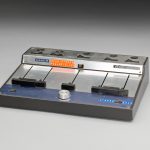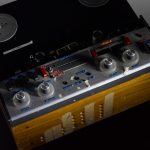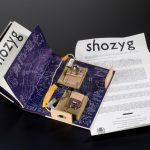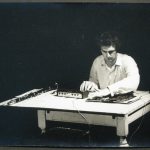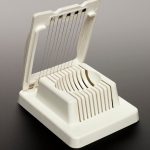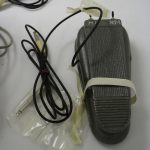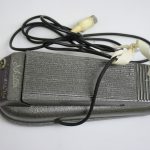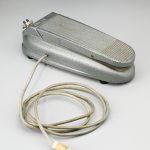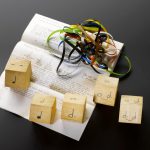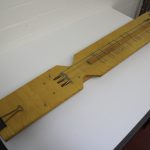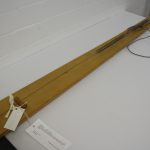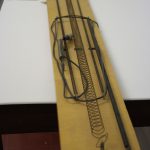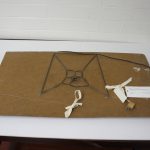The Hugh Davies Collection: live electronic music and self-built electro-acoustic musical instruments, 1967-1975
Article DOI: https://dx.doi.org/10.15180/170705
Abstract
The Hugh Davies Collection (HDC) at the Science Museum in London comprises 42 items of electronic sound apparatus owned by English experimental musician Hugh Davies (1943–2005), including self-built electro-acoustic musical instruments and modified sound production and manipulation hardware. An early proponent of ‘live electronic music’ (performed live on stage rather than constructed on magnetic tape in a studio), Davies’s DIY approach shaped the development of experimental and improvised musics from the late 1960s onwards. However, his practice has not been widely reported in the literature, hence little information is readily available about the material artefacts that constituted and enabled it.
This article provides the first account of the development of Davies’s practice in relation to the objects in the HDC: from the modified electronic sound apparatus used in his early live electronic compositions (among the first of their kind by a British composer); through the ‘instrumental turn’ represented by his first self-built instrument, Shozyg I (1968); to his mature practice, where self-built instruments like Springboard Mk. XI (1974) replaced electronic transformation as the primary means by which Davies explored new and novel sound-worlds. As well as advancing knowledge of Davies’s pioneering work in live electronics and instrument-building and enhancing understanding of the objects in the HDC, this article shows how object biographic and archival methodologies can be combined to provide insight into the ways in which objects (instruments, technologies) and practices shape each other over time.
Keywords
critical organology, DIY, experimental musical instruments, Hugh Davies, live electronic music, material culture, Science Museum
Introduction
https://dx.doi.org/10.15180/When I first began working in live electronic music in England in the summer of 1967 I was the only musician in the country to do so, unless one considered the amplification of conventional instruments by means of contact microphones to be included in the description. By the beginning of 1968, I had not only built some small amplified instruments, but had also started to use ring-modulation, switching devices and a light-controlled photocell sound distributor…
The Hugh Davies Collection (HDC) at the Science Museum in London comprises 42 items of electronic sound apparatus owned and used by the English experimental musician Hugh Davies (1943–2005). These include several electro-acoustic musical instruments built by Davies in the late 1960s and early 1970s, and a range of other electronic sound production and manipulation hardware used in his composition and performance activities from 1967 onwards. Many of the items have been modified for musical use.
The HDC was obtained by the Science Museum in 2005, with three reasons for the acquisition being given in the Museum’s records. First, the acquisition provided ‘an opportunity to collect specific significant items that are not already represented in the collections’, including ‘Wasp and Alpha Syntauri synthesizers and tape recorders used and modified for musical use’. Second, the objects were considered to represent ‘the analogue to digital transition’ in music technology, from the ‘rudimentary […] laboratory oscillators and contact microphones’ that ‘generated a DIY aesthetic’ in the 1950s and 60s, through to the digital and computer-based systems that began to dominate from the 1980s onwards. The ‘DIY era’, the record goes on to note, ‘has largely passed […] so this is a rare and valuable moment to collect equipment that represents […] the role of DIY in relation to technology’. Finally, the objects were considered valuable by virtue of their connection to Hugh Davies, ‘a significant figure’ who served as personal assistant to the avant-garde composer Karlheinz Stockhausen, contributed substantially to the Grove Dictionary of Musical Instruments and, in the late 1960s, ‘served as a conduit into the music scene for more abstract, sound-based, music, influencing areas of jazz, electronic and classical music and especially improvisatory performance’ (Boon and Emmens, 2005).
Davies’s contributions to experimental electronic music go beyond those mentioned in the Museum’s acquisition records. After producing what is still the most comprehensive documentation of electronic music’s early development – the monumental International Electronic Music Catalog (Davies, 1968b) – Davies went on to establish, in 1967, the first electronic music studio at a UK higher education institution: the Electronic Music Workshop (EMW) at Goldsmiths, University of London (Gilby, 1987). Davies was also, by his own reckoning at least, the first British composer-performer of ‘live electronic music’ – music in which sounds are electronically manipulated live on stage, as opposed to being assembled off-stage in a tape-based electronic music studio, as was the norm in the mid-1960s. Along with Richard Orton (1940–2013), Davies formed a live electronics duo, which was essentially the first of its kind in Britain. Davies and Orton soon went on to join the larger live electronic music ensemble, Gentle Fire.[1] From 1969, Davies was also a member of the innovative free improvisation group Music Improvisation Company (MIC).
Despite these achievements, Davies’s practice as a composer and performer of live electronic music is represented only rather diffusely in the extant literature.[2] The following account has therefore been reconstructed from a range of published, unpublished, and archival sources.[3] In particular, no previous study has focused upon the development of Davies’s practice as reflected in the material artefacts that enabled it, an approach that has been made possible in the present article by virtue of the author’s access to the objects in the HDC.
The objects in the HDC reflect the development of Hugh Davies’s practice as a composer and performer of live electronic music, from his earliest live electronic compositions of winter 1967–1968, through his subsequent innovations in instrument-building and ensemble performance, to the establishment of his mature practice as an instrument-builder, solo improviser and more occasional ensemble member. The objects in the HDC also represent several significant milestones in the history of (live) electronic music in Britain. A number of the objects were included in the original equipment purchase for the Goldsmiths EMW, the first electronic music studio at a UK higher education institution. Others were used in Davies’s early live electronic compositions, which are among the first such works by a British composer, while others still were used in performances by the Davies/Orton duo and Gentle Fire, Britain’s first experimental live electronic ensembles.
The approach taken in this article is essentially object biographic: it explores the circumstances in which the objects in the HDC were acquired or built by Davies, and subsequently used.[4] By tracing the development of Hugh Davies’s practice through and as informed by the objects in the HDC, this article provides an historic context within which these objects can be understood.
Beginnings
https://dx.doi.org/10.15180/170705/002Hugh Davies first became interested in electronic music in the late 1950s, while a pupil at London’s Westminster School. At this point in time, ‘electronic music’ was an esoteric affair, which involved recording source material on magnetic tape (real-world sounds in the case of musique concrète, electronically-generated signals in the case of elektronische Musik[5]), transforming the sounds through various tape manipulation techniques, and assembling the final composition by cutting and splicing the tape together.[6] Davies’s first practical experience of electronic music came through Daphne Oram (1925–2003), composer and former studio manager of the BBC Radiophonic Workshop. In 1962, he and a friend produced their first piece of electronic music, Essay for Magnetic Tape, at Oram’s Tower Folly studio. By this time, Davies was a student of Music at Oxford University, where he independently produced several further pieces of electronic music on magnetic tape, as well as setting up a makeshift studio there – tape-based, of course (Palermo, 2015).
Davies was also a keen researcher, documenter and writer, and by the age of twenty had produced a detailed discography for the British Institute of Recorded Sound, a 25,000-word thesis charting developments in electronic music in twenty different countries, and an article in which he evaluated the potential of electronic music as one of a number of emergent techniques and trends in avant-garde music (Mooney, 2015). In 1963, he began a new writing project: a short book about the music of the avant-garde composer Karlheinz Stockhausen (1928–2007). Although ultimately never published, it was through researching this book that Davies came to be invited to work as Stockhausen’s personal assistant. He moved to Cologne in 1964 and remained there for the next two years (Mooney, 2016d, p 102).
Working with Stockhausen
https://dx.doi.org/10.15180/170705/003 [7]On his first day as Stockhausen’s assistant, Davies experienced a new kind of electronic music: rather than being assembled on magnetic tape in the studio, the sounds that Stockhausen and his ensemble were making were being produced and electronically manipulated live on stage, with no use of tape whatsoever. Stockhausen was rehearsing his latest composition, Mikrophonie I, a piece in which the sounds of a tam-tam gong are electronically transformed. Two performers strike, scrape, or otherwise excite the surface of the tam-tam using a range of objects including kitchen implements, cardboard tubes, and electric motors. Two further performers capture the sounds via handheld microphones, which they move around according to detailed directions in the score. The position of each microphone relative to the tam-tam is thus constantly changing, and this affects the loudness and timbral qualities of the sounds that the microphones pick up; hence, the ‘microphonists’ play an active part in transforming the tam-tam sounds. Two more performers use electronic filters and potentiometers (volume controls) to transform the sounds further still before the results are amplified and projected via loudspeakers. The overall result is a combination of acoustic and electronically altered tam-tam sounds (Stockhausen, 1989).
Davies quickly became fascinated by the novel sound-world and unconventional performance techniques of Mikrophonie I. On the second day of his apprenticeship, he noted in his diary that:
The sounds no longer seem strange or at times crude; their microstructure becomes more alive when one gets to know the sounds better… I listen to the tape [Stockhausen] made in his garden with Jaap Spek [a member of Stockhausen’s ensemble] in August, using a plastic egg-timer, glass and shoe to ‘excite’ the tam-tam. This was the only actual experiment that he made for Mikrophonie I: even on this tape there is a very rich and wide range of timbres. During the rehearsals I find that I am beginning to know what sounds and sound characteristics Stockhausen will prefer. I am particularly interested by the sounds produced by the Massagegerät (hand held vibro-massaging machine) and the plastic propeller, both of which are electrically powered.
(Davies, 1968d), p 9
Davies operated filters and potentiometers in several concert performances of Mikrophonie I during his time as Stockhausen’s assistant, as well performing for a commercial recording (reissued on CD, Stockhausen, 2011) and documentary film (Dhomme, 1966).[8]
Another of Stockhausen’s works that Davies encountered was Mixtur, a piece in which the sounds produced by several groups of orchestral instruments (woodwind, brass, percussion, plucked strings, bowed strings) are transformed via an electronic process known as ‘ring modulation’.[9] Four ring modulators with sine-wave generators are used to independently modulate the sounds of the orchestral groups. (The percussion sounds are not modulated.) The generators are operated by four performers, who follow directions in the score that prescribe the frequency (pitch) settings for each generator. This results in timbral and rhythmic transformations of the orchestral sounds. In performances of Mixtur, Davies operated one of the sine-wave generators. A third piece along roughly similar lines – Mikrophonie II for choir, Hammond organ and ring-modulators – was also performed by Davies while he was in Cologne.
As a performer in Stockhausen’s ensemble, Davies gained hands-on knowledge of the tools and techniques of the emerging idiom of live electronic music, and a first-hand understanding of the new sonic possibilities that it engendered. He also encountered other experimental music techniques during his time in Germany. He experienced the spatial projection of sound via multiple loudspeakers for the first time during a lecture in which Stockhausen played his tape-based works Gesang der Jünglinge and Kontakte, for instance (Davies, 1968d, 10).[10] He also attended a solo performance by the percussionist Max Neuhaus, in which contact microphones were attached to percussion instruments and acoustic feedback used for musical effect (Davies, 2005, quoted in liner notes by David Toop).
In 1966, Davies’s apprenticeship with Stockhausen formally ended. Soon after returning to England, he attended a performance in London by John Cage, David Tudor, Gordon Mumma, and the Merce Cunningham Dance Company, in which Cage’s Variations V was performed. Sound material from pre-recorded magnetic tapes and shortwave radios was shaped by the movements of the dancers on stage by way of light-sensitive photocells and proximity-sensitive antennas that controlled the distribution of sound via a custom-built audio mixer, while ‘[a]dditional sonic material was contributed directly by the dancers through contact microphones embedded in objects they handled. Every action involving these objects was amplified’ (Miller, 2001, pp 551–554). It was a concert that Davies would continue to cite as influential for decades to come (Davies, 2001, p 54). Shortly after this, Davies travelled to Paris, and then to Trumansburg, NY (home of the Moog synthesizer company), to work on his International Electronic Music Catalog (Mooney, 2015).
Live electronic compositions
https://dx.doi.org/10.15180/170705/004It was on returning to England in 1967 that Davies began to acquire the objects that now constitute the HDC. Keen to pursue live electronics in his own compositional work, but no longer having access to Stockhausen’s equipment, he set to work with what little equipment he already owned or could build himself. In the first instance, this included little more than ‘contact microphones and a stereo mixer’ (Figure 1 and Figure 2) and ‘a sine/square wave generator’ (Figure 3), ‘stereo amplifier (2 x 10 watts) and 2 loudspeakers’ that he built from kits. For sound sources, he began to build makeshift ‘instruments’ comprising every-day objects fitted with contact microphones. These included a ‘comb quartet (SATB)’ and ‘springs stretched across a wooden bridge mounted on an upturned tin’. In the summer of 1967, Davies played these ‘instruments’ in improvisations with the like-minded musician Richard Orton (whom he had met the previous year during a visit to Cambridge), along with ‘shortwave radios, amplified fireguard and toy piano’ (Davies, 1970a). A DIY approach in Davies’s work was thus born out of necessity, as a way of exploring live electronic techniques with little money and no institutional support.
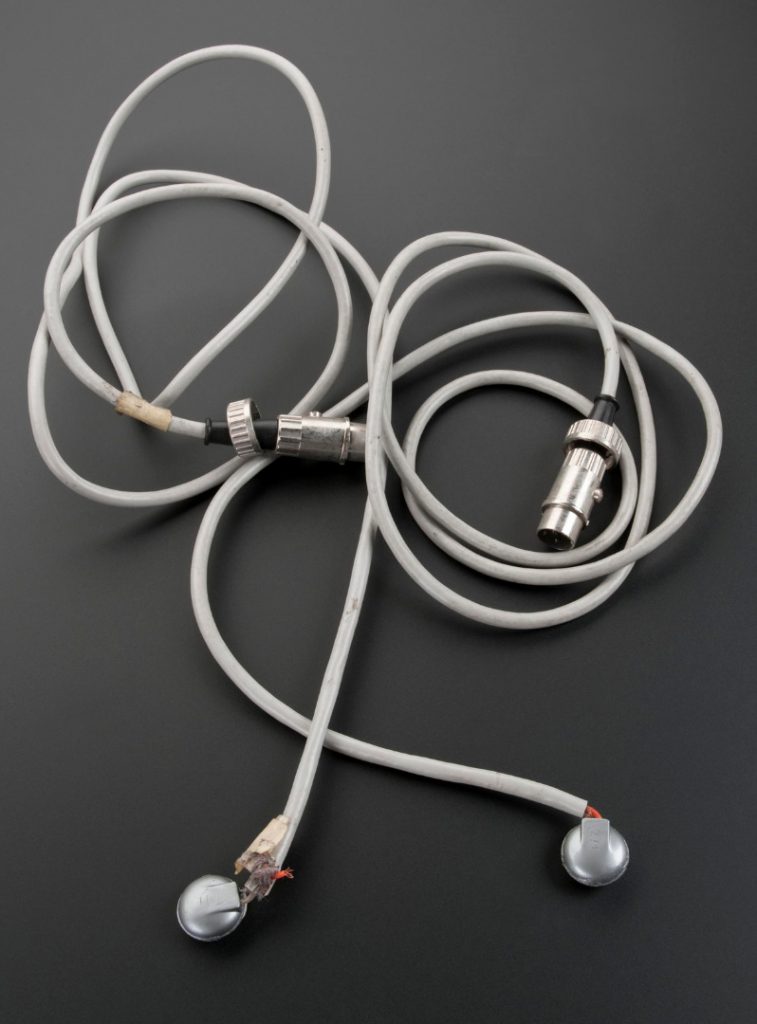
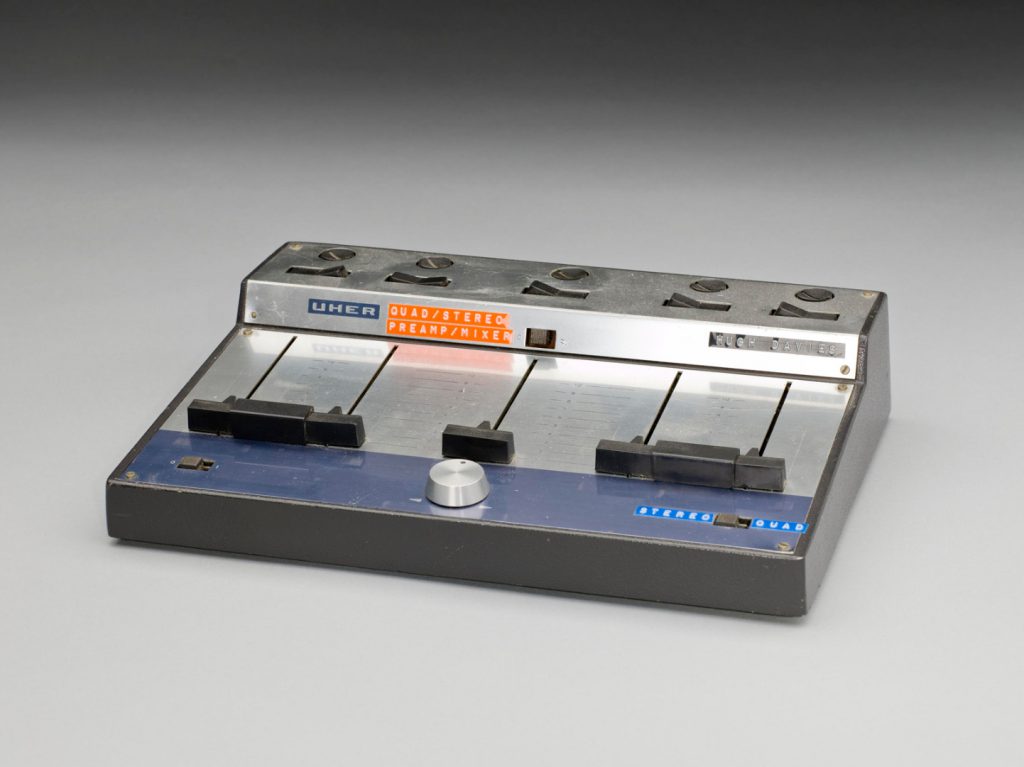
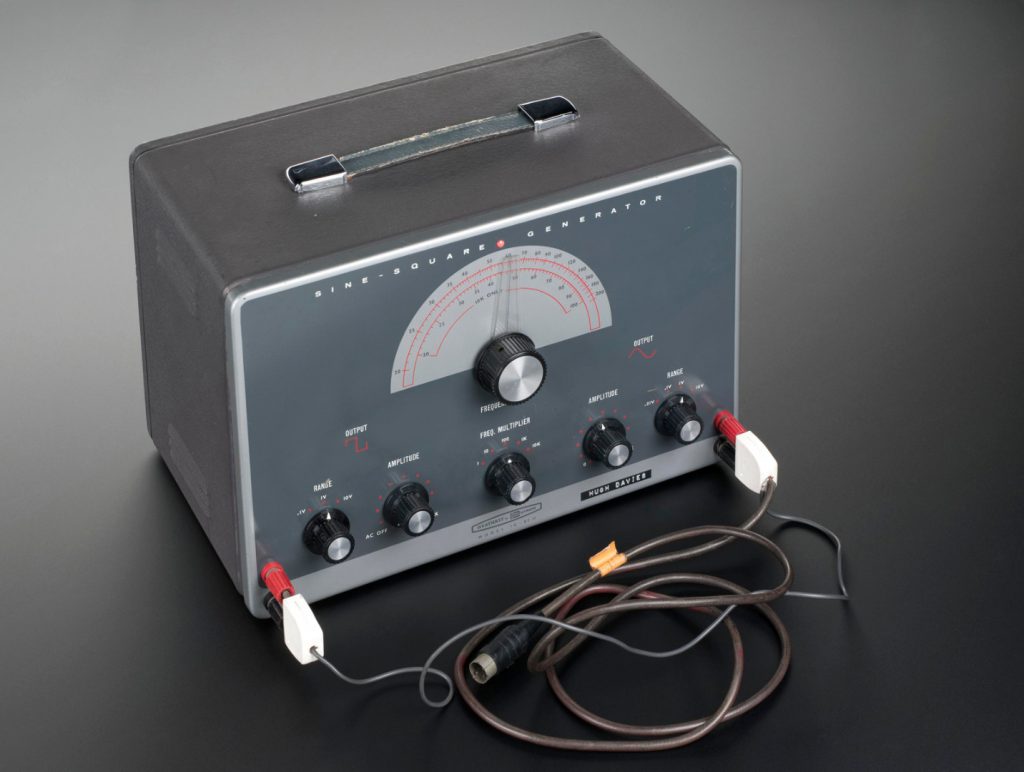
Before long, Davies moved to London, and developments began to pick up pace. He became the inaugural studio manager of a new Electronic Music Workshop (EMW) at Goldsmiths – a position that enabled him to acquire further equipment that he could not afford to purchase personally, including three high quality stereophonic tape recorders – all now in the HDC – one of which Davies promptly had modified so that its playback speed could be continuously varied (Figure 4) (Davies, 1977). He also became concert director for the Arts Laboratory in Covent Garden, an appointment that placed him at the heart of the capital city’s burgeoning experimental arts scene as well as providing ready access to a venue in which concerts could be staged. With these prerequisites in place, Davies was finally able to turn his attention to composition.
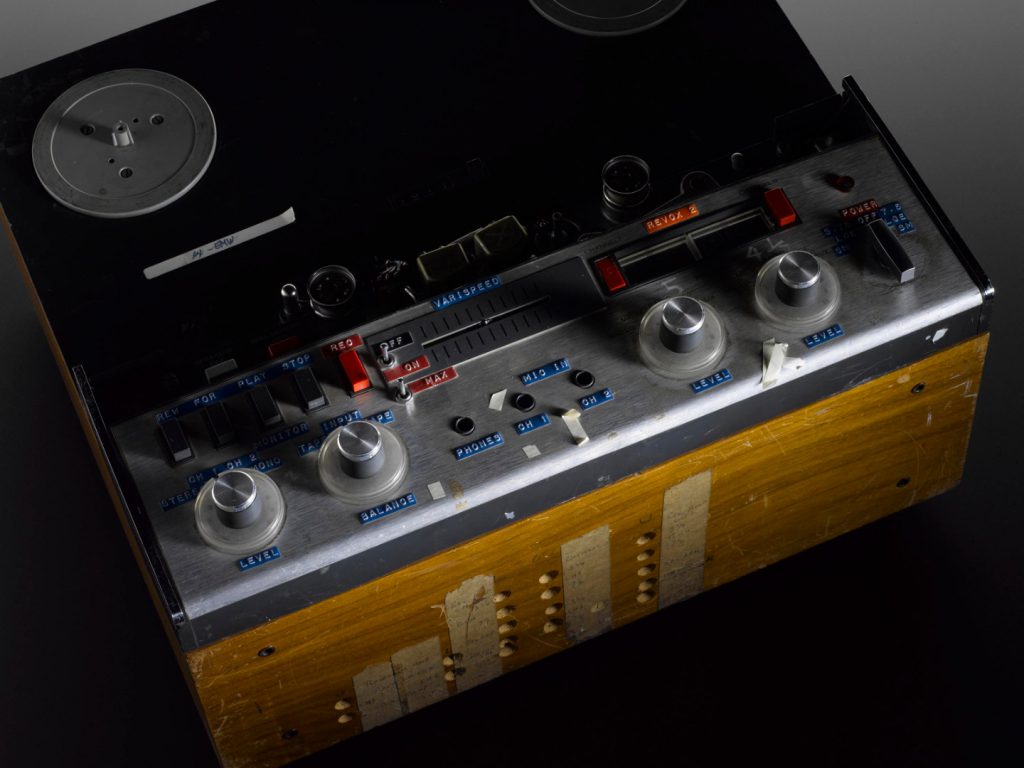
Around this time, Davies defined live electronic music in terms of the ‘electronic transformation of sounds’ during performance; whether the sound sources were ‘conventional instruments […] found or adapted objects […] electronic oscillators [or] recordings’, it was their electronic transformation that defined the practice of live electronic music (Davies, 2001, p 54). Several of the objects in the HDC were used by Davies for this purpose in his live electronic compositions of 1967–1968. As well as being among the first such compositions by a British composer, these pieces highlight the influence of Stockhausen, Cage/Tudor/Mumma, and Neuhaus upon Davies’s early practice. (See Postscript for details of recordings of the pieces discussed in this section.)
In Quintet (Alstrabal……) (1967–1968),[11] Davies used his battery-powered Uher mixing console (Figure 2) to control the generation of acoustic feedback via microphones and loudspeakers, while a sine/square wave generator (Figure 3) was used ‘to modulate (without actually employing a ring-modulator) the microphone feedback’ (Davies, 1967).[12] Four performers (players 1 through 4) are positioned in the four corners of the performance venue, each standing in front of a loudspeaker, and each equipped with a handheld microphone. They generate acoustic feedback – a form of electro-acoustic oscillation – by holding the microphones close to the loudspeakers, in accordance with instructions in the score that describe the required actions and sounding results. For example: ‘Move the microphone slowly in different directions, producing increasingly wider pitch intervals’; or ‘Fade sounds in and out by hand movements between the microphone and the loudspeaker’ (Davies, 1967; Davies, 1971). A fifth performer (player 5), seated at the centre of the hall, controls the levels of all the microphones and the routings of microphones to loudspeakers, and thus has overall control of the other players’ ability to produce feedback. In Davies’s own realisations of Quintet, this was achieved by using the Uher mixing desk to control levels, and a four-channel switching unit custom-built by Davies to determine the routings. Player 5 is also equipped with a microphone and a further pair of loudspeakers, which are used to produce feedback for Player 5’s solo in the middle of the piece – during which the sine/square wave generator is used to modulate the feedback sounds.
The use of feedback for musical effect was something that Davies had previously seen in performances by Max Neuhaus. It is also likely that Davies would have experienced the accidental ring-modulation of acoustic feedback during rehearsals with Stockhausen; indeed, as the author has noted elsewhere, evidence suggests that it was the experience of trying to avoid feedback in rehearsals of Mikrophonie I that provided the inspiration for exploring it deliberately and explicitly in Quintet (Mooney, 2016d, p 105). As Davies did not possess a ring-modulator, however, the use of such a device in Quintet was not possible.
By the time Davies composed Galactic Interfaces (1967–1968),[13] however, he had built two of his own ring-modulators (Davies, 1970a), which he used along with two sine/square wave generators to transform the sounds produced by amplified every-day objects and pre-recorded sounds from magnetic tape. In Galactic Interfaces, four improvising performers produce sounds using ‘various small “instruments”, specially constructed [and] fitted with contact microphones’ (Davies, 1968a); these were, of course, the ‘instruments’ built by Davies in the summer of 1967. Further sound material is supplied by two stereophonic magnetic tapes, prepared by Davies at Goldsmiths EMW in early 1968. In performance, the sounds from the ‘instruments’ and tapes are transformed electronically (using the ring-modulators/generators plus an optional fuzz-box) and projected via four loudspeakers via a light-sensitive sound distribution device, again, built by Davies.[14] As well as the four-channel switching unit mentioned previously, the four independently adjustable input channels of Davies’s Uher mixer were exploited, and it is likely that the after-market addition of a pre-amplification stage to the mixer – indicated by the labelling seen in Figure 2 – was done to enable the performance of this piece, by providing the high impedance inputs needed when using contact microphones.[15]
Given the similarities in the equipment used (contact microphones to amplify every-day objects, light-sensitive photocells, etc.), it seems reasonable to suggest that Galactic Interfaces was influenced by the performance of Cage’s Variations V that Davies recently attended. There are also echoes of Stockhausen’s practice in the use of close amplification (as in Mikrophonie I), ring-modulation (as in Mixtur), and quadraphonic sound projection (as in Gesang der Jünglinge and Kontakte). A further connection to his experiences as Stockhausen’s assistant can be seen in Davies’s performance directions, which specify that the amplified objects should be ‘made to sound by a variety of different “strikers” […] of a variety of different materials’, a requirement that invites comparison to the performance techniques that Davies witnessed in Mikrophonie I.
Finally, in Not to be Loaded with Fish (1968–1969),[16] Davies used a cheap, battery-powered record player – now part of the HDC (Figure 5) – which he modified so that the record could be played forwards or backwards at the flick of a switch. In advance of a performance, the performer is expected to make a gramophone recording at a public ‘record your own voice’ booth.[17] ‘The record is to be made vocally,’ Davies explains, ‘with as much variety as possible (e.g. breathing, growling, murmuring, whistling, intoning, etc.) but excluding conventional singing’ (Davies, 1969).[18] In performance, this record is to be played forwards and backwards ad lib – using the flick-switch on the modified record player – such that the performance lasts ‘approximately twice the length of the record used’ (Davies, 1969). The performer also dynamically controls the stereophonic distribution of sound by manipulating two potentiometers (volume controls) – once again, Davies’s Uher was used for this purpose – as well as ‘chopping up’ the sound from the record player by operating a custom-built ‘2-channel pulsing unit’ consisting of two repurposed telephone dials through which the audio signals are routed.[19]
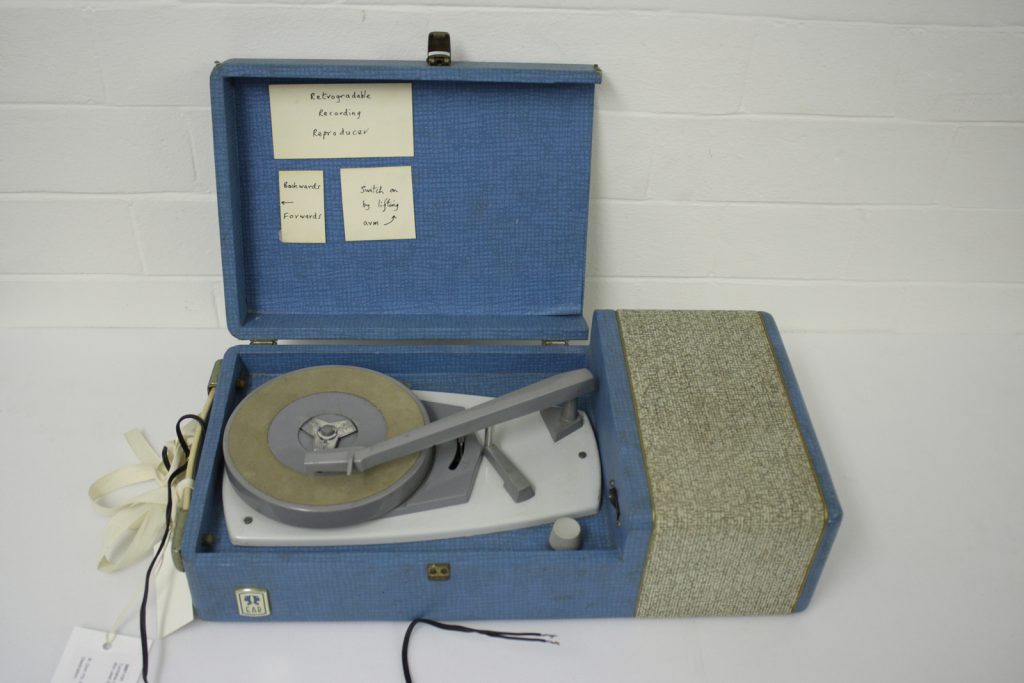
The objects discussed so far – the modified record player (Figure 5), the tape recorders borrowed from the Goldsmiths’ EMW (Figure 4), Davies’s Uher mixer (Figure 2), and the sine/square wave generators (Figure 3) that now reside in the HDC, as well as the various other items that did not find their way into the HDC, the ring-modulators, the four-channel switching unit, even the ‘record your own voice booth’ – are the material evidence of Davies’s early career as a composer-performer of live electronic music, which by Davies’s own reckoning was the first such career in England. However, the makeshift ‘instruments’ built by Davies in the summer of 1967, and subsequently used in Galactic Interfaces, prompted further experimentation by Davies along those lines, ultimately resulting in a turn away from live electronic music per se, and an increased focus upon instrument building.
Shozyg: an instrumental turn
https://dx.doi.org/10.15180/170705/005In summer 1968, Davies assembled a collection of found objects – fretsaw blades, a ball-bearing furniture castor, a spring – and mounted them, together with a pair of contact microphones, inside the cover of a book. Since the book was an encyclopaedia volume covering the alphabetic range of topics from SHO to ZYG, he called the resulting object a ‘shozyg’. Soon afterwards, he assembled and mounted a second collection of objects in a similar way – two springs, a rubber band, and a set of guitar machine heads (Davies, 1968c). Shozyg I and Shozyg II, as Davies dubbed these constructions, were conceived as ‘the final stage in a series of specially built small instruments using objects made of wood, metal, glass, plastic, etc. that are amplified by means of contact microphones’ (Redcliffe Concerts of British Music, 1969). As such, the instruments were supposed to provide a logical conclusion to the series of makeshift ‘instruments’ used in Galactic Interfaces.
Shozyg I and II are ‘electro-acoustic’ instruments, in that the sound is generated acoustically, and amplified electronically (Davies, 2000a, p 45). Twenty copies were eventually made of Shozyg I, and four of Shozyg II; one of the copies of Shozyg I now forms part of the HDC (Figure 6).
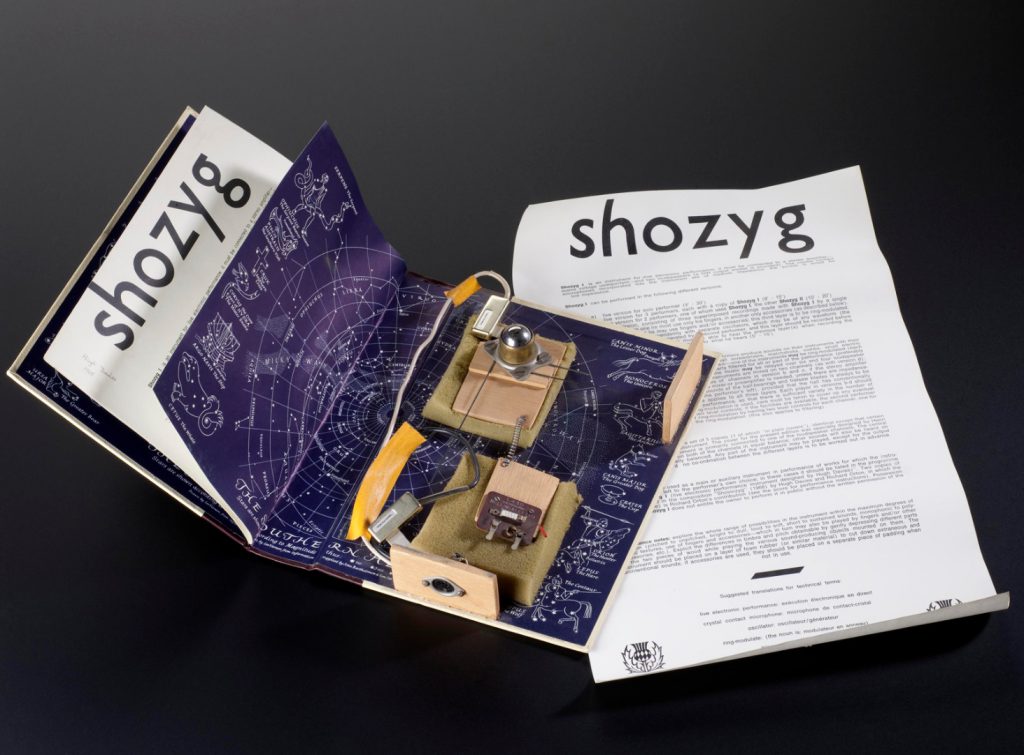
Davies referred to Shozygs I and II as ‘instrument[s] for live electronic performance’ (Davies, 1968c) – an important development, since he had never previously referred to any of his apparatus, self-built or otherwise, in precisely those terms.[20] With the instruments he supplied text-based instructions, which effectively served as scores for a set of three similarly-named live electronic compositions: Shozyg I, Shozyg II, and Shozyg I and II.[21] Shozyg I existed in three versions: a ‘live version for solo performer’ playing Shozyg I; ‘live version for 3 performers, each with a copy of Shozyg I’; and a ‘tape version, consisting of three superimposed recordings made with Shozyg I by a single performer’. Shozyg II was ‘for solo performer’ playing Shozyg II, while Shozyg I + II was ‘for 2 performers, one of whom uses Shozyg I, the other Shozyg II’. In all except the tape version, Davies specified that the instruments could optionally be routed via a pair of ring-modulators (one for the left channel, one for the right; Shozyg I and Shozyg II are both stereophonic instruments), with the oscillators being operated by an additional performer (Davies, 1968c).
Although the Shozyg compositions were, broadly speaking, improvised, the text-based scores provided specific directions concerning playing techniques – ‘performers produce sounds on their instruments with their fingers and/or accessories such as needle files, small screwdrivers, matchsticks, combs, small electric motors, small brushes, coins, keys, etc.’ (Davies, 1968c) – as well as a precise indication of how each instrument’s timbral compass was to be explored. The player of Shozyg I was instructed to:
explore the whole range of possibilities in the instrument within the maximum degrees of variation (pitched to unpitched, bright to dull, loud to soft, short to sustained sounds, monophonic to polyphonic textures, the use of fingers and accessories – which in turn may also be played by fingers and/or other accessories, etc.).
Like much experimental music of the 1960s, then, the Shozyg pieces were improvised within a framework bounded by specific conditions – including performance directions, material constraints such as the physical properties of the instruments themselves, and (where applicable) interactions between players – which shaped the musical results in characteristic (and broadly predictable) ways.
The scraping, ratcheting, metallic timbres produced by the Shozyg instruments invite comparison to the sound-world of Mikrophonie I, which had fascinated Davies so much upon his arrival in Cologne, while the performance directions for the Shozyg pieces might be seen as a formalisation of the techniques developed through the use of Davies’s makeshift ‘instruments’ of the summer of 1967, as discovered through his own sonic-tactile explorations (in improvisations with Richard Orton, for example), and through his observations of the techniques employed by the players when using these ‘instruments’ in performances of Galactic Interfaces.
The Shozyg instruments represent a rationalisation of Davies’s practice that was partly necessitated by his increasing involvement in live performance engagements, often in other cities. The Davies-Orton duo toured England, delivering ‘some 10 concerts in the course of a year’ and travelling many miles in the process (Davies, 2001, p 54). In November 1968, Davies joined Gentle Fire, an ensemble that Orton had established through informal experimental music activities at York University (Davies, 2001, p 54), and in early 1969 he joined free jazz musicians Derek Bailey, Evan Parker, and Jamie Muir to form the Music Improvisation Company (MIC). By the time Davies stopped performing with MIC in 1971, he had joined another group, Naked Software, such that between 1968 and 1973, he was never in any fewer than two different performing ensembles (Davies, 1997, p 14). In the context of an increasingly hectic performance schedule, the practicalities of travel and inevitably limited setup and rehearsal time highlighted the need for equipment that was compact, portable, and self-contained – all properties that the Shozyg instruments possess.
A photograph dated July 1968 (Figure 7) – the month of the instrument’s debut performance – shows how Davies played Shozyg I: seated at a table, with the Uher mixer (see also Figure 2; used to adjust the relative levels of the two contact microphones during performance), and his clarinet. (See the Postscript section for details of recordings of Shozygs I and II.)
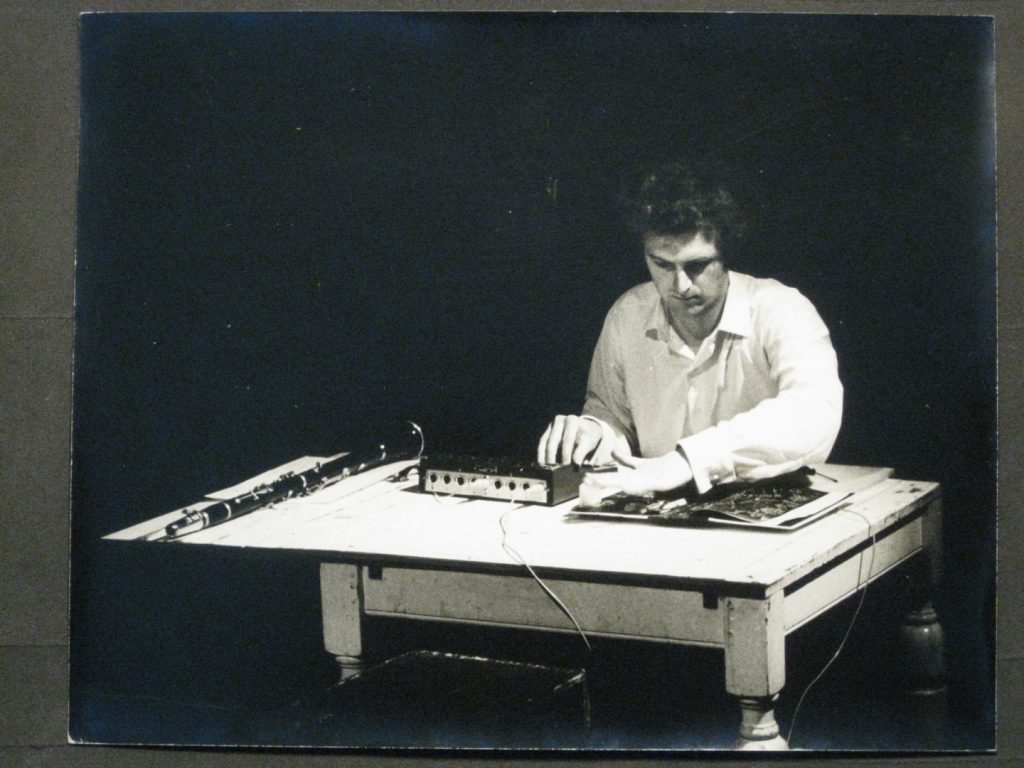
Hugh Davies: instrument maker
https://dx.doi.org/10.15180/170705/006 [22]Shozygs I and II marked the beginning of an instrumental turn in Davies’s practice, after which instrument-building gradually superseded composition as his primary creative activity. The term ‘shozyg’ was adopted by Davies as a term to describe ‘any instrument (usually amplified) built inside an unusual container’ (Roberts, 1977). Several such instruments were built by Davies in 1969, though the majority of these were intended, not for concert performance, but for exhibition in art galleries as sound sculptures – a new format for Davies, but one that he would continue to pursue for the remainder of his career, in parallel with his performance-oriented activities.
Davies began to diversify his performance instrumentarium in other ways, however, namely through the addition of individual found objects intended for use as auxiliary sound sources alongside his fully-fledged concert instruments. The first such objects to be used by Davies were coiled metal springs, and a metal-stringed egg-slicer (Figure 8). These were amplified via an electromagnetic pickup – a new method for Davies – which had been salvaged from a telephone handset (Davies, 1997, p 12). Thus, in 1969, several springs, an egg-slicer, and an electromagnetic pickup were added to Davies’s performance table. The springs were played by stretching them by hand and dragging them across the pickup – an interaction that was assisted by the addition of key-rings at the ends of some of the springs (Toop, 1974, p 5). The egg-slicer was played by plucking the ‘strings’ and squeezing the frame or stopping the strings on the circular rim of the telephone pickup in order to control the pitch (Davies, 1981, pp 173–174). This setup was ‘first used in group improvisations in 1969’ (Toop, 1974, p 5), which are likely to have included some of Davies’s earliest public performances with the Music Improvisation Company.
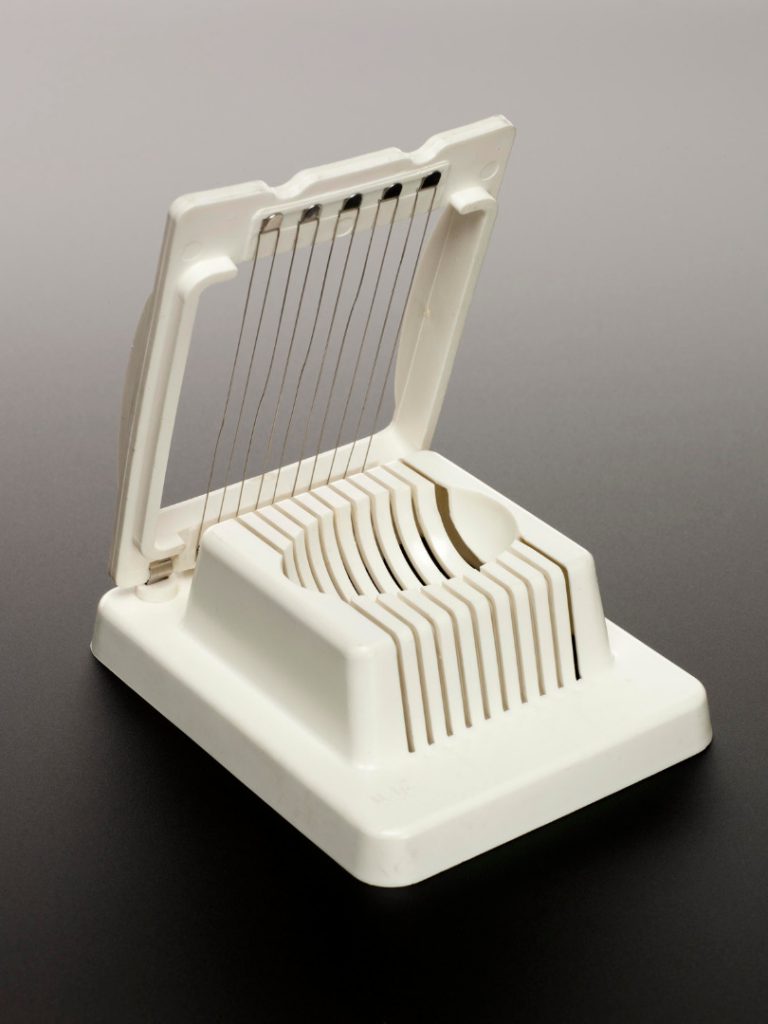
The use of loose springs and egg-slicers soon led to the development of further concert instruments by Davies, as he sought to rationalise and augment the musical affordances of these simple found objects. His attempts ‘to construct a more varied egg slicer’ (Davies, 1981, p 174) quickly led him to develop the Aeolian Harp, an instrument comprising several ‘thin fretsaw blades […] mounted in a holder […] and […] blown on by the human breath as well as played with a variety of miniature implements such as a feather and a single hair from a violin bow’ (Davies, 1997, p 13).
Davies’s experiments with loose springs, on the other hand, led to the construction of five new concert instruments in 1970 that he referred to as Springboards – instruments in which a number of springs were attached under tension to sections of blockboard, and amplified via electromagnetic pickups. Springboards Mk. I, Mk. II, and Mk. IV comprised four springs each and represented different approaches to the geometric arrangement of springs (parallel, fan-shaped, etc.), pitch marking (marked or unmarked), and performance ergonomics (easy to play versus visually striking) (Davies, 1981, pp 168–171; Scottish National Gallery of Modern Art, 1975). Springboard Mk. III, comprising fourteen springs, was devised as both an exhibition piece and a concert instrument, and was thus designed to be visually striking as well as musically ergonomic. It was also the first Springboard to feature a new method for attaching the springs to the board, by hooking them all to a single metal keyring at one end. ‘[B]ecause all the springs meet at the central key ring,’ Davies later noted, ‘a form of “artificial” reverberation is added by undamped springs’ (Scottish National Gallery of Modern Art, 1975). Springboard Mk. V – a higher-pitched ‘soprano’ springboard – comprised just two springs mounted in parallel. At 6 cm wide, this was ‘more portable and in some ways more flexible in performance’ than the other Springboards. Thus, it was the most suitable candidate for regular inclusion on Davies’s performance table, where it was used alongside Shozygs I and II, the egg-slicer, and the loose springs and pickup.
Davies recorded several improvised solos on his Springboards, and gave these the title Spring Song (Davies, 1970c). The first live solo performance on a Springboard, delivered some years later, took the same title, and was described in Davies’s programme notes as ‘[o]ne of the earliest of Hugh Davies’s solo compositions for his instruments’ (Davies, 1970b). Davies clearly considered Spring Song to be a composition, then; however, there is no score for it; no notation, nor any indication of what kind of musical material should be played. Rather, it seems that any solo performance on a Springboard is, by definition, a performance of Spring Song. In effect, it is the instrument itself that defines the composition.[23] (For recordings of Spring Song, see Postscript.)
Another innovation prompted in part by Davies’s increasingly busy performance schedule was a set of three specially modified foot-pedals – now part of the HDC – which provided a compact and portable way of achieving live electronic sound transformation. The first of these pedals, constructed by Davies in 1970 (Toop, 1974, p 5), was a homemade ring-modulator ‘with a choice of two oscillators’ (Davies, 1997, p 14) housed inside the casing of a commercially-available volume pedal (Figure 9).[24]

The following year, Davies added a further two pedals: a commercial ‘wah-wah’ unit of the kind typically used by guitarists (Figure 10), and a fuzz distortion and phase-shift pedal custom-built for Davies, again, inside the casing of a commercial volume-control pedal (Figure 11); both of these pedals were further modified by Davies so that they could optionally function as simple volume controls, bypassing the sound transformation circuitry, thus adding further flexibility to his performance setup while keeping the number of pieces of equipment required to a minimum.
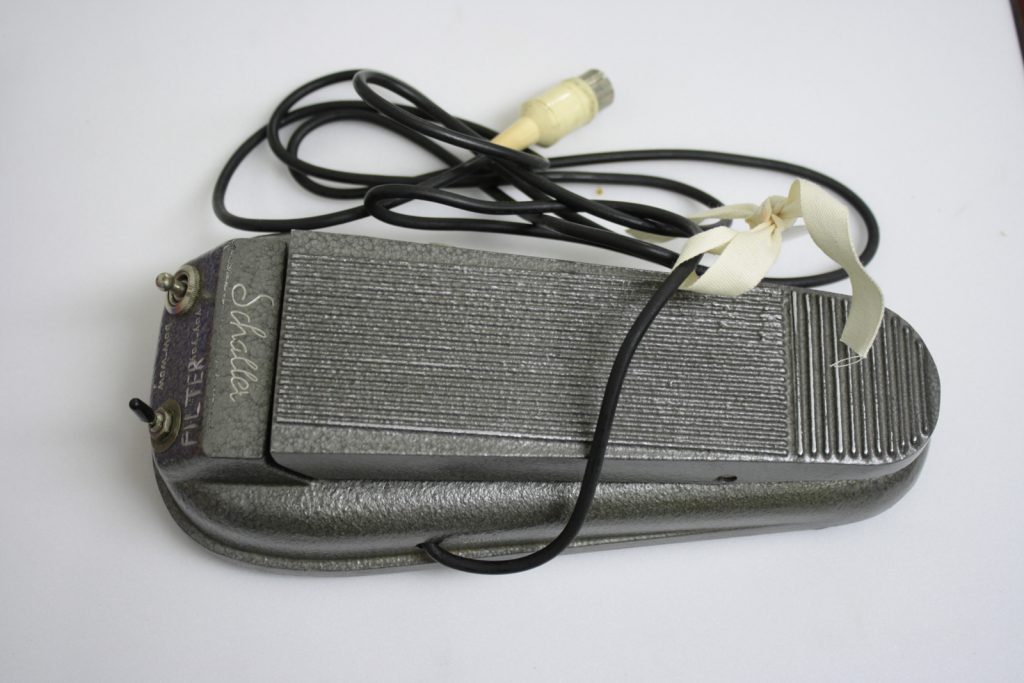
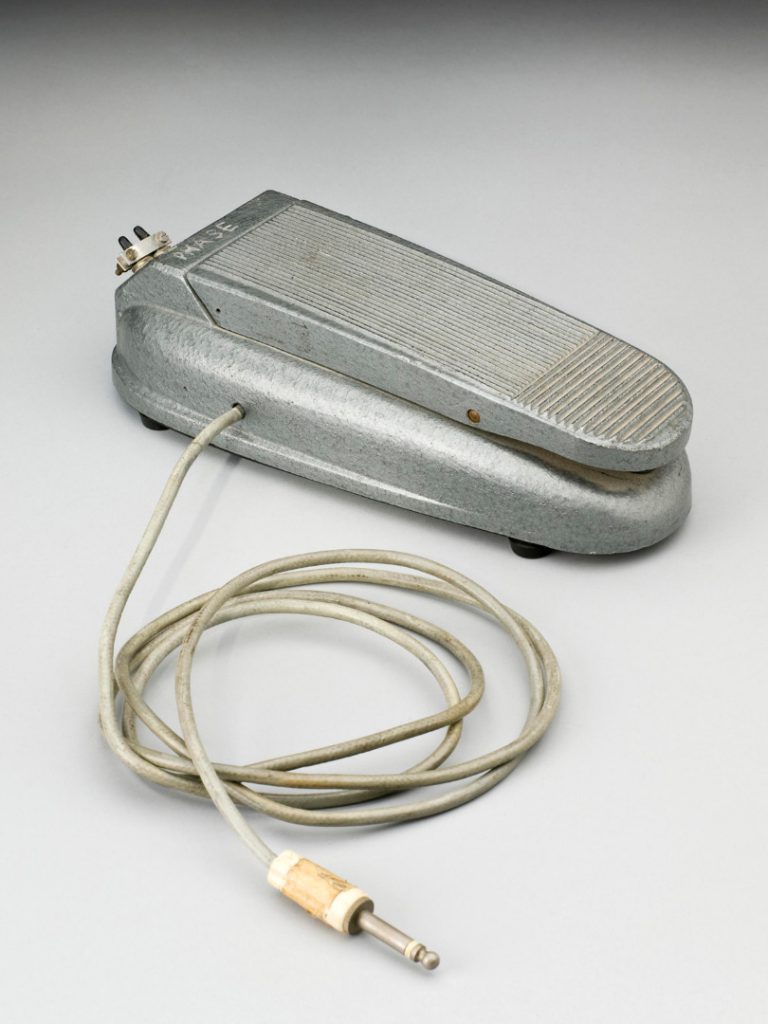
The pedals were routinely used by Davies in his ensemble performance activities up to about 1971 (roughly corresponding with Davies’s last performances with MIC), as a way of electronically transforming the sounds produced by his self-built instruments, thus augmenting the range of timbres at his disposal (Davies, 1981, p 510; Davies, 1997, p 14; Davies, 2001, p 56).
Gentle Fire’s 'Group Compositions'
https://dx.doi.org/10.15180/170705/007From 1968 to 1975 Davies was a member of Gentle Fire, an ensemble that specialised in the performance of experimental music with live electronics (Davies, 2001; Mooney, 2016d). In 1970, Gentle Fire devised the first of six Group Compositions – pieces devised collectively by all the members of the ensemble, and described by the group as ‘environment[s] in which our […] group musical personality has a chance to resonate’ (Bernas, Davies and Robinson, 1973). For Group Composition II (1971), the six ensemble members produced ‘scores’ for each other, ‘which describe[d] the interaction and ensemble characteristics of playing together’ (Bernas, Davies and Robinson, 1973). These were not conventional ‘scores’ of Western classical notation; rather, they contained text-based instructions, graphics, and symbols, as well as tape-loops and other physical apparatus devised so as to shape the unfolding of the musical material. ‘[T]he individual parts,’ Davies later explained, ‘were composed as separate layers, without any of us knowing what the other layers would consist of’ (Davies, 2001, pp 58–59). Graham Hearn’s score for Hugh Davies – now part of the HDC (Figure 12) – comprised written instructions, a tape loop, and a set of five thick wooden pentagons whose sides were inscribed with musical notes and rests of various durations. The pentagons were to be arbitrarily arranged before a performance, such that they spelled out a rhythmic pattern of notes and rests. This was to be followed by Davies when applying live electronic transformation to the sounds produced by the other musicians on ‘two cellos, piano (interior), [and] electronic organ’ (Davies, 2001, p 58). Specifically, the rhythmic pattern was to be iteratively repeated by Davies (ostinato is the musical term), with periodic changes governed by the contents of the tape loop and the activity of the other players. The tape loop contained five different recordings of the sound of a telephone ringing, and was to be played silently throughout the performance, its volume raised only intermittently, ad lib. Whenever this was done, the telephone ring that happened to be playing at that moment determined which of the five pentagons had to be rotated, so that a different one of its sides – and hence a different note or rest value – substituted the old one. Whether the pentagon was to be rotated by one, two, three, or four faces was determined by what another member of the ensemble – assigned to that particular pentagon prior to the performance – happened to be playing at that moment: a high-pitched sound meant rotate the pentagon by one face; a low-pitched sound, two faces; medium-pitched, three; or if the performer was playing in several registers simultaneously, four. Thus, the five pentagons provided a variable score for Davies’s part in Group Composition II, which resulted in ‘a slowly evolving rhythmic cycle of electronic transformations (primarily filtering and ring-modulation) of what was played by the musicians’ (Davies, 2001, p 59).
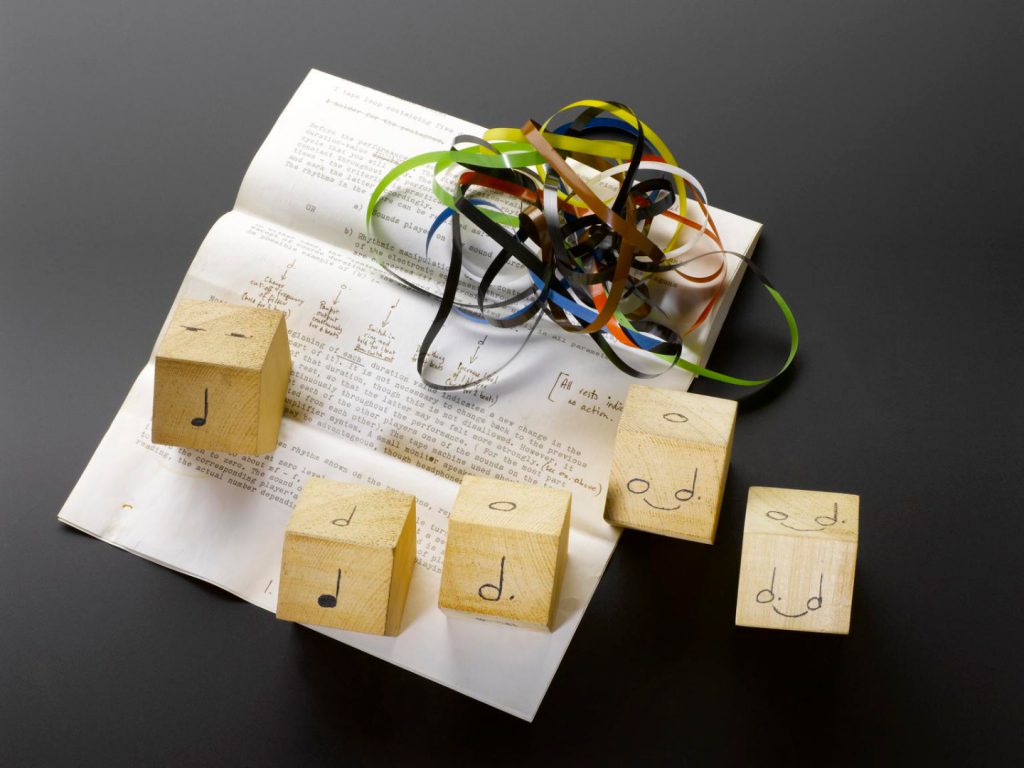
The other ensemble members’ scores were different, but equally complex in their determinations, each influencing performer interactions in different ways so that the music would unfold in complex and unpredictable ways, despite the fact that each of the players was following specific instructions at any given moment. As Michael Robinson put it, ‘[o]ur movements are circumscribed but they’re not predictable’ (Bernas, Davies and Robinson, 1973). After Richard Orton left Gentle Fire, Group Composition II was reworked as a quintet, which was dubbed Group Composition V; hence, the materials in the HDC bear the handwritten inscription ‘Group Composition II > V’.
Instrument-building and performance
https://dx.doi.org/10.15180/170705/008Davies continued to develop his shozyg table alongside work with Gentle Fire, and in 1971, gave his first solo performances using it (Davies, 1997). By this time, he had added a further found object to the table – an amplified ‘3D photograph […] whose grooves are played by running fingernails across them at different speeds’ – as well as a guitar string ‘whose tension is varied by [a] bamboo holder, […] plucked and […] bowed with a violin bow’, and amplified via a record player cartridge (Toop, 1974, p 5). (This was a method of amplification with which Davies was already familiar, since it had been used in Gentle Fire’s performances of John Cage’s Cartridge Music.)
The same year, Gentle Fire was invited to participate in the world première of Sternklang, a new composition by Stockhausen, and Davies conceived and built two new ‘Stringboard’ instruments – note: ‘string’ rather than ‘spring’ – for the occasion. One of these Stringboards now resides in the HDC (Figure 13). It is similar in construction to the Springboards, but since Sternklang required the performers to play specific pitches accurately, Davies used cello strings rather than springs, which were tuneable via pegs, and included frets and pitch names on the instrument’s body. The instrument was designed to be played by bowing.
Distinctively, Sternklang makes use of only 9 of the 11 possible notes of the chromatic scale, so that the notes D-sharp and F-natural are never played at any point during the piece. Examination of the Stringboard reveals that there are no D-sharps or F-naturals marked out on the instrument’s body and, furthermore, that the precise layout of the frets (i.e. the distances between one note and the next) correspond with the specific chords used in Sternklang. This proves beyond reasonable doubt that the instrument in the HDC is one of the two Stringboards that Davies built for use in this piece.
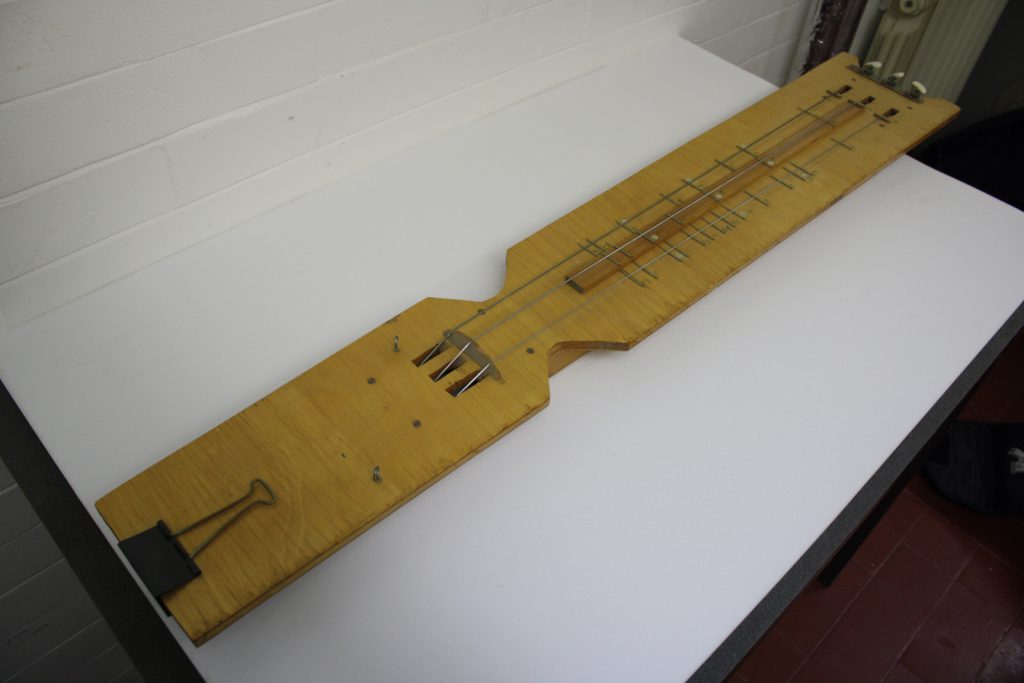
Davies played his ‘self-built stringed instrument’ for the world première of Sternklang, but ultimately was not convinced that the instrument was musically effective, and switched to clarinet for Gentle Fire’s later performances of the work (Stockhausen, 1992). A few years later, Roberts noted that ‘[t]he small number of instruments that Davies has devised for the purpose of playing in specific pieces (e.g. the Stringboard Mk. I (1971) and Mk. II (1972) for Stockhausen’s Sternklang) have not, he feels, been the most satisfactory, especially where specific pitches were called for: he prefers to let the impulse come from the materials themselves’ (Roberts, 1977, p 8).[25]
Nonetheless, the experience of building and performing with the Stringboard appears to have influenced Davies’s subsequent instrument-building activities. In 1972, he began building a new instrument, subsequently described as standing ‘midway between’ the Springboard and Stringboard types (Roberts, 1977, p 12). Springstring – a one-off instrument, which now resides in the HDC (Figure 14) – comprised two interconnected semi-springs (coiled springs with a straight, elongated metal hook at each end) with a single pickup for amplification. The tension of the springs, and hence the sounding pitch of the instrument, could be adjusted via a tuning peg, and the instrument was intended to be played by bowing; both features invite comparison with the Stringboards that Davies had recently built and played.
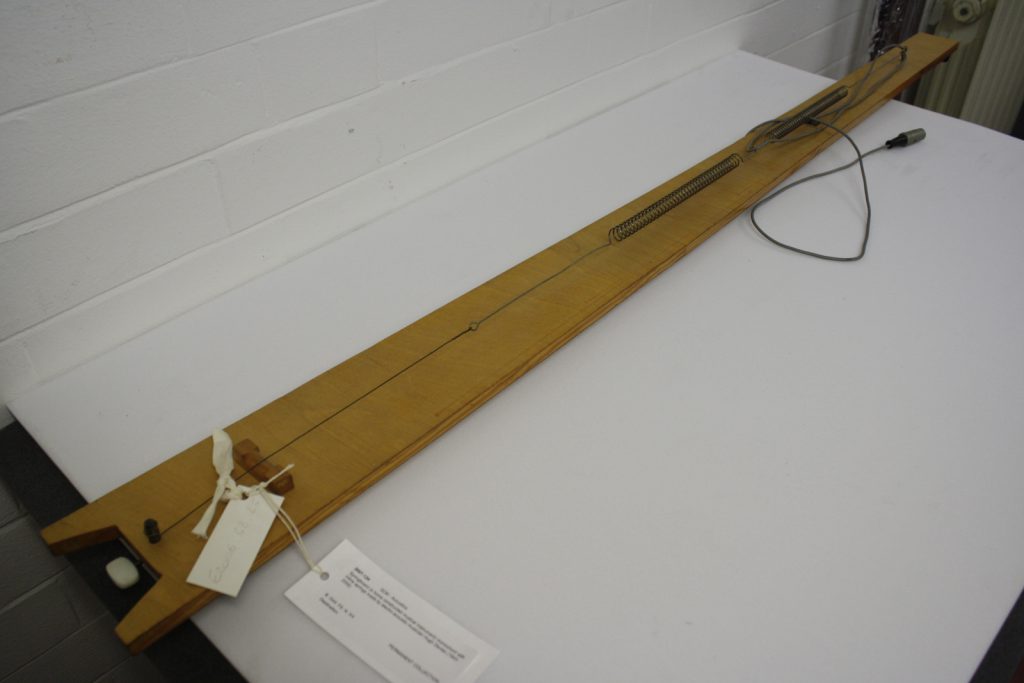
Self-built instruments supersede live electronics
https://dx.doi.org/10.15180/170705/009In 1973, Davies began a new phase of Springboard development, in which he sought to further diversify the instrument family’s sonic capabilities. Whereas the early Springboards had all used springs of identical dimensions, for Springboard Mk. VI (Figure 15) – now part of the HDC – Davies used four springs of different sizes plus one semi-spring to produce a ‘contrabass member of the family’ (Scottish National Gallery of Modern Art, 1975). It was lower in pitch and, at 133 cm in length, larger in physical dimensions than any of the previous Springboards (Davies, 1981, p 170). The largest spring, mounted centrally and stretched almost the full length of the instrument, had a fundamental frequency of 7 Hz, roughly two octaves lower in pitch than the lowest note on a piano. With Springboard Mk. VII, on the other hand, Davies extended the size and pitch range of the Springboard family in the opposite direction, with a ‘pocket-sized soprano’ version (Scottish National Gallery of Modern Art, 1975).
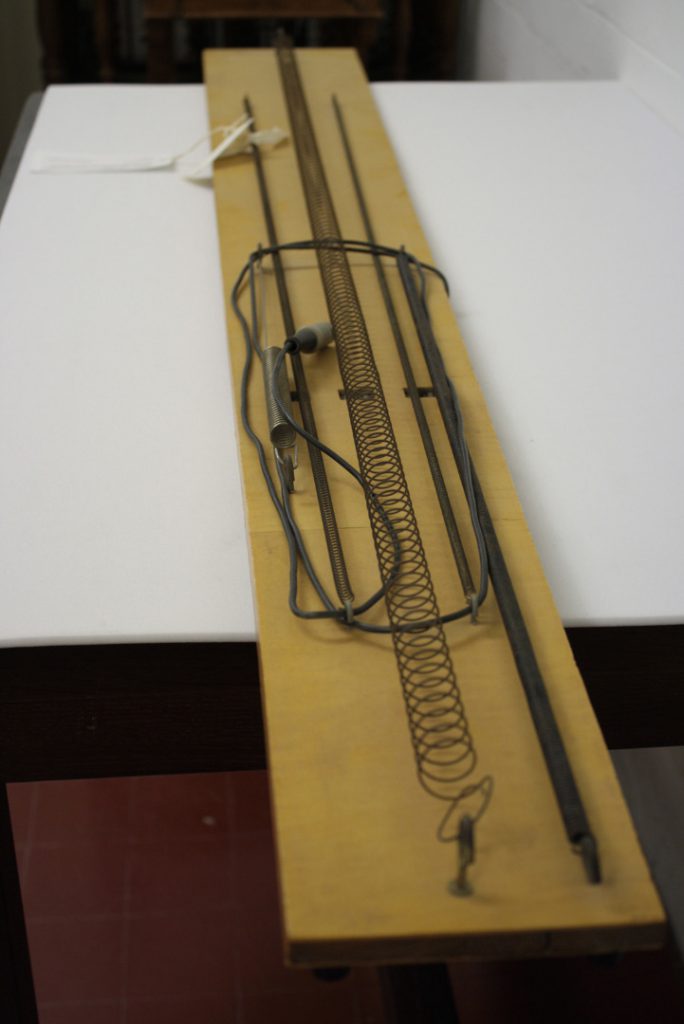
The next year, Davies built a further three Springboards that explored the ‘built-in reverberation’ feature first developed in Springboard Mk. III. In Springboard Mk. VIII, ‘the idea of the central keyring of Mk. III [was] developed’, while Springboard Mk. X, in turn, represented an ‘expansion of the idea of Mk. VIII, adding a second, concentric “keyring” with smaller springs connecting the two’. ‘Complex changes in filtering and reverberation may be produced in this model’, Davies observed, ‘by altering through damping the route that the vibration from a plucked spring must travel to reach the pickup’ (Roberts, 1977, p 12). These new developments culminated in the building of a prototype for Springboard Mk. XI – now part of the HDC (Figure 16) – ‘continuing the development of the keyring principle, replacing the larger ring by individual springs’ (Scottish National Gallery of Modern Art, 1975, p 2), and ‘so permitting slightly more subtle filtering’ (Roberts, 1977, p 12).[26]
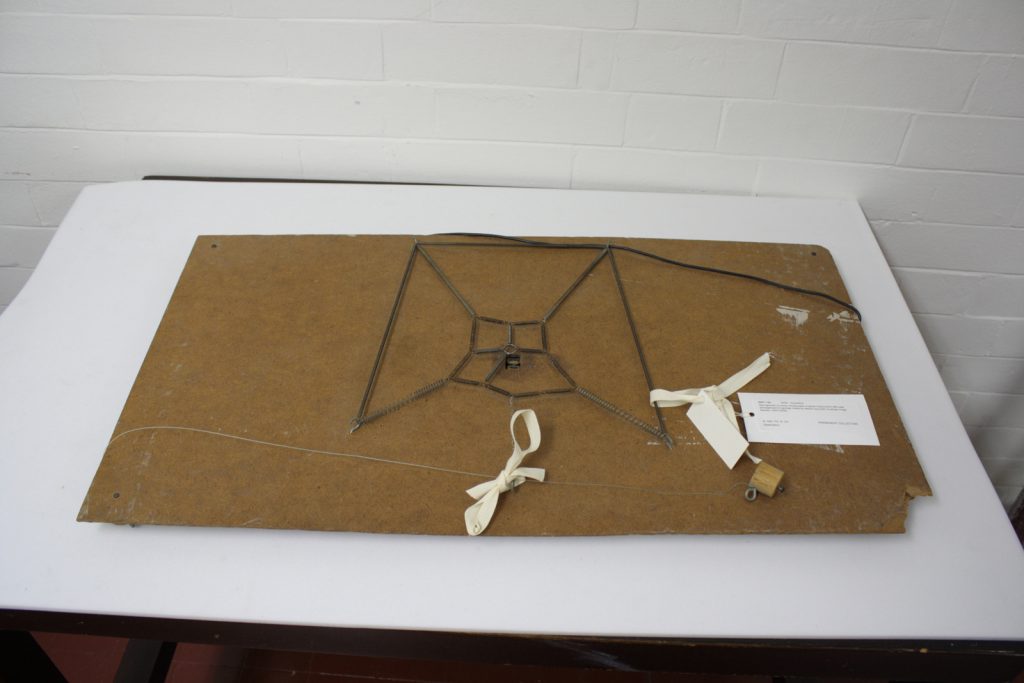
Around this time, while reflecting upon his experience as a performer in live electronics ensembles, Davies noted that:
a general tendency has been to start out by assembling a substantial amount of personally-owned equipment for sound modification as well as for amplification, and then to find that the way in which the performers produce sounds on their instruments becomes increasingly closer to the sounds previously obtained by using transformation equipment… This [trend] is further substantiated by an increasing interest among the musicians involved in live electronic music in constructing new, usually amplified instruments whose sounds range from ones associated with conventional instruments to those of electronic music. These sounds are, furthermore, “natural” to the instruments …
In other words, Davies was aware that, increasingly, he was able to achieve, via his self-built instruments alone, the kinds of sonic results that he had once obtained via live electronic processing. Indeed, Davies later noted that ‘[o]n several occasions, without initially realising it, I have built into an electro-acoustic instrument the equivalent of a piece of electronic music transformation equipment such as a filter, reverberation unit or certain kinds of modulation’ (Davies, 1981, p 163).
Davies’s Springboards – of which a dozen different models were ultimately produced[27] – provided the basis for a composition for small ensemble entitled Gentle Springs (Davies, 1972). Each of the four or five players was to choose a different Springboard, and ‘[explore] the “musical personality” of the Springboard that he/she has chosen’. No indication was given as to what sounds should be produced on a moment-to-moment basis; rather, the performance was supposed to be improvised, the sonic characteristics of the music being defined primarily by the distinctive sonic and tactile affordances (Mooney, 2010) of the instruments themselves. Notably, no live electronic transformation of the Springboard sounds was prescribed: the composition showcased the unadulterated sounds of the instruments, which were themselves able to reproduce many of the timbres that Davies had once achieved via live electronic transformation.
Gentle Springs illustrates how Davies’s creative priorities began to shift after the instrumental turn. Put simply, he went from being a composer who built ‘instruments’ for use in his live electronic compositions (as in Galactic Interfaces), to being an instrument-builder who composed as a way of showcasing his instruments (as in Gentle Springs).
A solo career
https://dx.doi.org/10.15180/170705/010Alongside his work with Gentle Fire, Davies continued to perform as a soloist, delivering regular one-man concerts and lecture-recitals using his self-built instruments, as well as exhibiting them in art galleries. By the time Gentle Fire gave its last concerts in the summer of 1975 (Davies, 2001, p 56), Davies was well established as a solo artist, instrument-builder, and performer. After Gentle Fire disbanded, he concentrated on solo work using his shozyg table – by this time rebranded as a ‘solo performance table’ (Toop, 1974, p 5) – as well as participating in regular group improvisations with like-minded musicians and instrument-builders, including Lily Greenham, Peter Cusack, John Russell, Roger Turner, Hans-Karsten Raecke, and others. He also remained active as a composer, and continued to exhibit his instruments regularly, both in solo shows, and alongside the work of other instrument-builders such as David Toop, Max Eastley, and Paul Burwell, whose group exhibition ‘New and Rediscovered Musical Instruments’ included all of Davies’s Springboards (Scottish National Gallery of Modern Art, 1975).
By this time, Davies’s DIY approach to music-making had taken on a more explicitly political slant. His use of ‘junk’ materials was being described ‘as a corrective to the wastefulness of modern society’ and a way of ‘demonstrating that much of what is ordinarily thrown away as worthless may still have a useful life’, while his instrument-building workshops with children (an activity he had pursued sporadically since the late 1960s) aimed to ‘encourage awareness that the resources of the planet don’t need to be used and discarded so rapidly’ (Roberts, 1977, p 10). Thus, Davies’s DIY approach – originally born out of necessity – became in his later career an explicit statement against consumer culture, and a way of promoting environmental sustainability.
Summary: from composer to instrument-builder and performer
https://dx.doi.org/10.15180/170705/011At the start of his career, Davies identified primarily as a composer. He began to compose using live electronic techniques after his apprenticeship with Stockhausen. The resulting compositions, Quintet, Galactic Interfaces, and Not to be Loaded with Fish, call for the live electronic transformation of sound sources – acoustic feedback, recordings on tape or disc, amplified objects. His first self-built ‘instruments’ (with scare quotes) were the amplified objects used in Galactic Interfaces, and his first self-contained instrument, Shozyg I, can be seen as a rationalisation of this, prompted by his increasingly busy concert schedule, which demanded equipment that was compact and portable.
Shozyg I marked an ‘instrumental turn’ in Davies’s practice; the point where instrument-building started to become an end in itself, rather than being secondary to composition. He started to build further instruments, totalling more than 120 in his lifetime (Roberts, 2001, p 61), and exhibited these in galleries as artworks in their own right, as well as playing them in concerts. The instrumental turn was paralleled by what Davies later described as a ‘progression from studio composer to solo performer’ (Davies, 1997, p 13). He assembled a performance instrumentarium – the shozyg table – comprising multiple self-built instruments and amplified found objects, which he played regularly as a soloist from 1971 onwards.
After the instrumental turn, Davies’s use of live electronic transformation began to diminish. This was partly because, as his instrumentarium grew, he was able to produce an increasingly wide range of timbres without electronics. Thus, Davies later recalled that he ‘rarely used’ his electronic sound transformation pedals in solo performances after about 1971 (Davies, 1997, p 14). It was also because Davies soon discovered that he could closely emulate the characteristic sounds of live electronics – reverberation, filtering, etc. – by exploiting the ‘natural’ sonic capabilities of the instruments themselves. Although this discovery was accidental – a by-product of using a single keyring mount for Springboard Mk. III – Davies actively developed it in his subsequent instrument-building activities, further diminishing the need for live electronics. In 1977, Roberts reported that ‘[al]though he has no fundamental objection to electronic modification of the signals produced by his instruments, Davies has used it very rarely’ (Roberts, 1977, p 10) – a stark contrast with Davies’s earlier practice, which placed electronic transformation centre stage.
Davies came to view his instruments as an alternative to studio-based electronic sound production methods. He called them ‘musique concrète synthesizers’ (Davies, 1997, p 14), a reference to their ability to instantaneously generate sounds that would take hours or even days to produce in a tape-based studio. Reflecting upon his practice in later life, Davies drew similar parallels:
Normally in building new instruments […], my sound sources are produced by found objects. My initial approach is very like that of a musique concrète composer, who will often explore found sounds that seem to have musical potential …
(Davies, 2002a), p 39
Conclusion: a career in objects
https://dx.doi.org/10.15180/170705/012The objects in the HDC reflect the development of Davies’s practice, from live electronics, through instrument-building, to the point where self-built instruments superseded live electronic transformation as his primary means for exploring new and novel sound-worlds. The devices Davies used in his live electronic compositions and early performances – sine/square wave generators (Figure 3), tape recorders (Figure 4), modified record players (Figure 5), and the three foot-pedals (Figure 9, Figure 10, Figure 11) – speak of a time when he thought primarily in terms of sound sources and their electronic transformation. Shozyg I (Figure 6) represents the ‘instrumental turn’ in Davies’s practice; the pivot point between the live electronics of his early career, and the self-built instruments that defined his mature practice, of which the Stringboard (Figure 13), Springstring (Figure 14), and Springboard Mk. VI (Figure 15) are examples. Springboard Mk. XI (Figure 16), with the built-in reverb and filtering effects created by its multiple interlinked springs, exemplifies how self-contained instruments superseded electronic transformations.
The objects in the HDC show how Davies shaped technology to meet the demands of his practice: he modified mixers, pedals, and tape recorders, and assembled collections of found objects (the Shozyg instruments) to meet his creative needs. On the other hand, Davies’s writings and other archival evidence highlight how his practice was shaped by encounters and interactions with technology: playing filters and potentiometers as Stockhausen’s assistant led him to adopt live electronics in his compositional practice; using found objects as sound sources prompted a shift from composition to instrument-building (the instrumental turn); finally, constructing, building, and playing his own instruments led Davies to abandon live electronics in his later work. Using objects and texts as evidence reveals how Davies’s practice shaped, and was shaped by, the objects in the HDC. Thus, this study shows how object biographic and archival techniques combine to provide insight into the ways in which objects (instruments, technologies) and practices shape each other over time.
Postscript: recordings
https://dx.doi.org/10.15180/170705/013The author has staged several concerts of Hugh Davies’s music, including performances of his live electronic compositions Quintet, Galactic Interfaces, and Not to be Loaded with Fish, and other related repertoire. Video recordings of these performances, along with pre-concert lectures and programme notes, have been published by the University of Leeds and can be accessed online: http://archive.researchdata.leeds.ac.uk/view/collections/Hugh_Davies=3A_Electronic_Music_Innovator.html (Mooney, 2016a; Mooney, 2016b; Mooney, 2016c).
A number of recordings of Davies’s self-built instruments can be accessed via the British Library’s Sound Server: http://sounds.bl.uk/Classical-music/Hugh-Davies-experimental-music/ (British Library Board n.d.). Of particular relevance to the objects in the HDC are several recordings of Shozyg I and Shozyg I & II (grouped under the heading ‘Shozyg’), recordings of 15 Springboard solos (under the heading ‘Spring Song’), and a recording of Galactic Interfaces. Other recordings featuring Davies’s self-built instruments include ‘At home’, ‘Double Aeolian Harp’, ‘H.D. Breadbins’, ‘Improvisation’, ‘Music for bowed diaphragms’, ‘Music for springs’, and ‘Solo performance’, while ‘Salad’ features the musical use of egg, cheese, and tomato slicers.
Commercial recordings featuring Davies’s self-built instruments or live electronic compositions have been released by Another Timbre (Davies, 2008; Davies et al, 2008), ECM (Music Improvisation Company, 2003), FMP (Davies, 1982), FMR (Davies, 1997b; Parker et al, 2003), GROB (Davies, 2000b), Incus (Music Improvisation Company 1992), Klangwerkstatt (Davies and Raecke, 1994), Parlophone (Talk Talk, 1988), Sub Rosa (Various artists, 2006), and on the CD accompanying Sounds Heard (Davies, 2002b).
Acknowledgements
The author would like to thank Tim Boon, Head of Research and Public History at the Science Museum in London, whose collaboration enabled access to the Hugh Davies Collection; and Sean Williams, Owen Green, and the other members of the ensemble Grey Area – Emma Lloyd, Dave Murray-Rust, Armin Sturm, and Shiori Usui – as well as Steve Beresford, Phil Minton, and Aleks Kolkowski, whose performances of Davies’s music played an essential role in this research. For their involvement in conversations that helped to shape this article, the author would also like to thank Simon Baines, Graeme Gooday, Ian Helliwell, Martin Iddon, Annie Jamieson, Robert Knifton, James Mansell, Tenley Martin, Richard Nicholls, Trevor Pinch, Philip Thomas, and the two anonymous peer reviewers whose comments helped me to add depth and nuance to the final text. Finally, thanks go to Graham Blyth, Rachel Proudfoot, and Brenda Williams, of the University of Leeds’ Research Data Management team, for their assistance in archiving performance recordings.
This research was supported by an Arts and Humanities Research Council (AHRC) Early Career Fellowship grant in partnership with the Science Museum, London, as part of the project ‘Hugh Davies: Electronic Music Innovator’. AHRC project reference: AH/M005216/1.
A note on references
In addition to the Hugh Davies Collection at the Science Museum in London (referred to in this article as HDC), there is also a collection of Hugh Davies’s manuscripts and papers, and a separate collection of recordings on reel-to-reel tapes, at the British Library, 96 Euston Road, London NW1 2DB, United Kingdom. For clarity, in the list of references that follows, the following abbreviations have been used:
HDM: Hugh Davies Manuscripts. Refers to Davies’s manuscripts and papers. British Library call number: MS Mus 1803
HDR: Hugh Davies Recordings. Refers to Davies’s recordings on reel-to-reel tapes. British Library call number: C1193
Tags
Footnotes
Back to text
Back to text
Back to text
Back to text
Back to text
Back to text
Back to text
Back to text
Back to text
Back to text
Back to text
Back to text
Back to text
Back to text
Back to text
Back to text
Back to text
Back to text
Back to text
Back to text
Back to text
Back to text
Back to text
Back to text
Back to text
Back to text
Back to text



